Stocks & Equities
Over the past two months shares of gold (NYSE:GLD) and Apple (NASD:AAPL) have had a sizable bite taken out of their share price. Active traders along with the longer term investors have had a wild ride this fall watching these investments slide to multi month lows. The big question is when will gold and apple shares bounce?
Here we are again with another election behind us and Barack Obama in the White House again. Many think this means four years of the same thing… Printing, Inflation and higher stock prices.
Is this good or bad for Americans or the world for that matter? I doubt it, but who really knows and who cares because there is nothing anyone can do about it now. So buckle up your seat belt and focus on trading and investing with major trend both within the United States and abroad using exchange traded funds.
Currently the broad stock market and commodities are in a full blown bull market so the focus should be to buy the dips until proven wrong. Below are some charts showing the important breakout levels for Apple, metals, oil and key indexes like the Russell 2000.
Be aware that during pullbacks which last more than a month which is the market has done, some of the biggest drops in price happen just before prices bottom… Scaling into positions is the key to minimal draw downs.
Russell 2000 Small Cap Index – IWM
Small cap stocks typically lead the broad market in both directions. They are the first to rally and the first to rollover and sell off. The major indexes like the DOW, SP500 and NYSE have not formed clean chart patterns which is why my focus is on the Russell 2000. Small cap stocks are now showing a rising relative strength compared to the SP500 large cap stocks and this is very bullish for stocks in general. The best way to trade this index is through the exchange traded funds IWM and TNA.
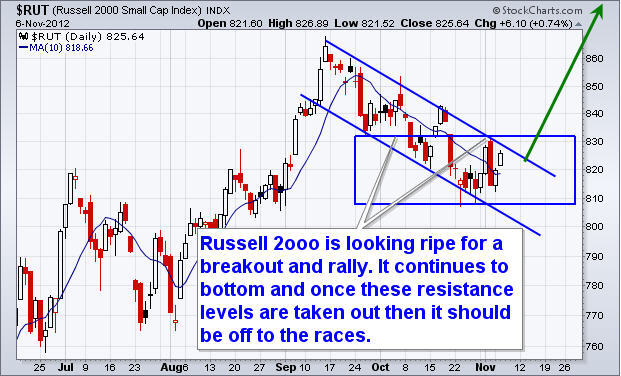
Ed Note: Click HERE to view 4 other charts and the Post-Election Trading Breakout Summary
WEEKLY COMMENTARY
This week’s Trading Lesson
Here is an excerpt from my upcoming book, The Mindless Investor, How to Make Money in the Market by Overcoming Your Common Sense. This piece is from the chapter, Be Fearless:
I think many traders have a hard time believing they can make money by buying a stock and waiting. Most of us are not taught to make our money work for us but instead that we must work for our money. Go to a job, put in the time and you get a paycheque. Work hard, and your paycheques will grow. But the thought that you can make money by putting your feet up is a difficult thing to grasp.
With that mental programming, most of us have difficulty holding on to our strong stocks and letting the profits grow. If we buy a stock at $1 and it goes up to $1.20 in a couple of days, we are likely to sell. In some ways we think of this fast return as good luck, not much different than buying a winning lottery ticket. We have a fear that someone is going to figure out that we have benefited from a mistake, and so we better get out now before we get discovered.
This thinking is strengthened when we take a trade that’s less than ideal and it goes down as quickly as it went up. If we take a marginal trade we should expect marginal results, but somehow we only remember the negative feeling of watching a paper profit turn into a loss. We tell ourselves that next time we will sell at the first sign of weakness and crystallize the gain. Avoiding pain is human nature.
Our next trade is of higher quality but we sell it on a short-term weakness and lock in a quick but relatively small profit. While lost in self-congratulations we realize that someone named Murphy is writing the laws of trading, and we watch the stock march ever higher with us eating the stock’s dust. We have jumped off a high-speed bus that is headed for Profit City.
What is behind this destructive behaviour? It’s that deep-rooted emotional response to danger that keeps us out of trouble but also makes us avoid a greater feeling of fulfilment.
Fear is what makes us sell our winners too early and hold our losers too long.
The best traders are not afraid of holding on to strong stocks, they are afraid of holding on to losing stocks. What do you do when you trade?
If you are a normal human being, you do the opposite of what the pros do. Think about the last loser that you owned. As the stock fell lower and lower, what was it that you told yourself over and over?
“It’ll bounce back eventually. I’ll just be patient.”
What your subconscious mind was really saying was, “It’s much too painful to sell this loser and see that loss of my hard-earned capital. I’ll hold on with the hope that it goes back to what I paid for it and then I’ll sell.” And of course, it continued lower because there was something wrong with the company and it deserved to go lower.
So what can we do to fight our destructive minds? How can we program ourselves to hold on to our winners and dump the losers? How can we trade without fear? Here are three of my seven criteria for fearless trading:
Only Trade Quality
Our fears are confirmed when we enter marginal trades. If you only trade the best opportunities, you will trade less but you will have greater success. This will put you on the road to fearless trading and help you simplify your trading approach. Write down your rules and do nothing unless every rule is satisfied. When you consider a stock, look for a reason to avoid the trade. If you can’t find one, then you have a trade worth taking.
Buy with Confidence
The rules that you trade with have to have a foundation of success. You have to believe in your rules or you won’t believe in holding the stock through the shakeout periods in the longer-term up trend. Analyze and test the strategy until you have proven to yourself that it works. Then trade it slowly without a lot of risk, so you can gain a greater level of confidence that it works.
Don’t Watch the Scoreboard
Sports fans don’t spend a lot of time watching the scoreboard during a game. It only matters when the game is over. In trading, the scoreboard is the profit and loss figure for your account. If you focus on the scoreboard, it is likely that you will lose sight of what’s happening in the game. As a technical trader, all that matters to me is what the chart is telling me.
STRATEGY OF THE WEEK
With the US election on Tuesday, the market has been very quiet recently with few investors willing to make a significant move ahead of the vote. Tonight, I ran a Market Scan on Stockscores with the following settings:
Sentiment Stockscore > 60
Breakout through 80 day Resistance
Volume above 20 day average
Trades > 250
Here are some of the stocks that I feel have good charts:
STOCKS THAT MEET THAT FEATURED STRATEGY
1. AIQ
AIQ is making a cup and handle pattern breakout with increasing volume over the past few days. Support at $1.33.
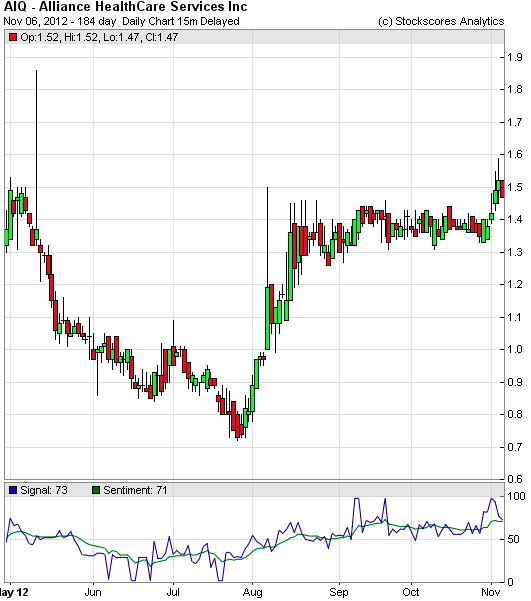
2. MSPD
I featured MSPD in the daily newsletter two days ago, it has been moving higher through resistance from an optimistic chart pattern. Support at $3.34.
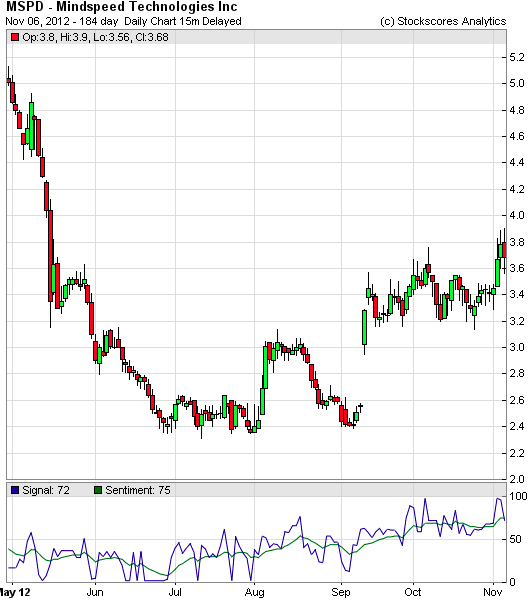
3. T.RIM
T.RIM (RIMM on Nasdaq) is shaping up as a nice long term downtrend reversal pattern. Support at $7.55.

Stockscores Mindless Investor Book Launch Special Event
Calgary Monday Nov 12 6:30 – 8:30 pm
Vancouver Tuesday Nov 13 6:30 – 8:30 pm
Click here for information and to register for this free event
Join me as I show some of the ways I use Stockscores.com to pick and track stocks and ETFs. This is an informal evening focused on the analysis of the current market and a hunt for ways to make money from it. Free to attend and copies of my new book, The Mindless Investor, will be available for purchase for $30. Please register to attend and let us know how many copies of the book you wish to purchase in the comments section of the registration page so we can bring enough copies.
Stockscores Trader Training
The 12 week Stockscores Investor and Stockscores Active Trader training programs start with the live Foundation class on November 24th in Vancouver and November 25th in Calgary. Click here to visit the information page.
Live Trading Day
For those who have completed the StockSchool Pro, Investor or Active Trader classes in the past, I will be doing a live trading day in Calgary on Monday November 26th. Watch me trade live and learn the processes I go through to find day and swing trading strategies. Emailtylerb@stockscores.com for more information.
Stockscores Market Minutes Video
Traders are challenged with finding the right stocks at the right time. The Stockscores Market Scan tool allows you to scan the market using a wide range of filters. In this week’s Market Minutes video, I demonstrate how to use it. You can watch this week’s video on Youtube by clicking here. To receive email alerts any time I upload a new video, subscribe to the Stockscores channel atwww.youtube.com/stockscoresdotcom.
References
- Get the Stockscore on any of over 20,000 North American stocks.
- Background on the theories used by Stockscores.
- Strategies that can help you find new opportunities.
- Scan the market using extensive filter criteria.
- Build a portfolio of stocks and view a slide show of their charts.
- See which sectors are leading the market, and their components.
Disclaimer
This is not an investment advisory, and should not be used to make investment decisions. Information in Stockscores Perspectives is often opinionated and should be considered for information purposes only. No stock exchange anywhere has approved or disapproved of the information contained herein. There is no express or implied solicitation to buy or sell securities. The writers and editors of Perspectives may have positions in the stocks discussed above and may trade in the stocks mentioned. Don’t consider buying or selling any stock without conducting your own due diligence.
“The entry point for the seasonal trade in North American equity markets is here”
The Bottom Line
The entry point for the seasonal trade in North American equity markets is here. The TSX Composite Index reached a seasonal low on October 15th at 12,132. The Dow Jones Industrial Average reached a seasonal low on Thursday October 25th at 13,040. Downside risk is limited and upside potential into early next year is above average. Average gain during an election year by the S&P 500 Index from November 1st to February 1st is 5.0%. Preferred strategy is to accumulate equities and Exchange Traded Funds with favourable seasonality at this time of year that already are showing technical signs of performance or outperformance relative to the market (S&P 500 Index for U.S. markets or TSX Composite Index for Canadian markets). Sectors include agriculture, forest products, transportation, industrials, steel, coal, mines & metals, consumer discretionary, home builders, semiconductors, China and Europe.
Mark Leibovit Comment: “Back to the stock market, we could very well see a rally to test or even see new highs because it is either that or ‘blood in the streets’. High unemployment, a still imploding Europe and now recovery from a major national natural disaster are all potential bullish factors if you’re a contrarian. But, if it comes (50/50 in my opinion), I would not wear out my welcome”.
The TSX Global Metals and Mining Index added 50.55 points (5.48%) last week. Intermediate trend is up. Short term momentum indicators are trending up. The Index remains above its 20 and 50 day moving averages and moved above its 200 day moving average on Thursday. Strength relative to the S&P 500 Index remains positive.
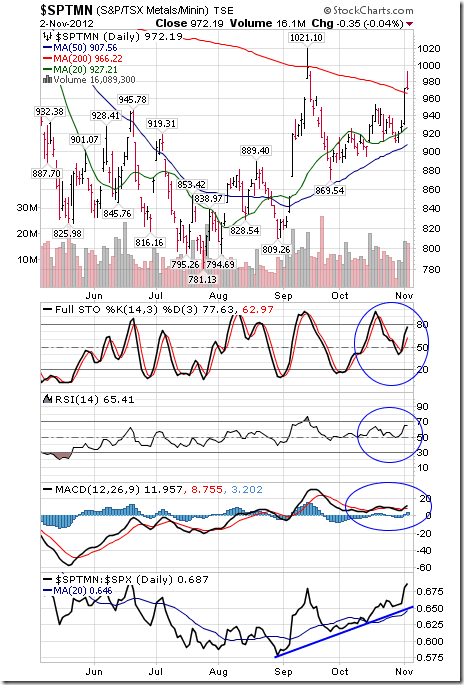
Lumber gained another $2.42 (0.76%) last week. Intermediate trend is up. Lumber remains above its 20, 50 and 200 day moving averages. Strength relative to the S&P 500 remains positive
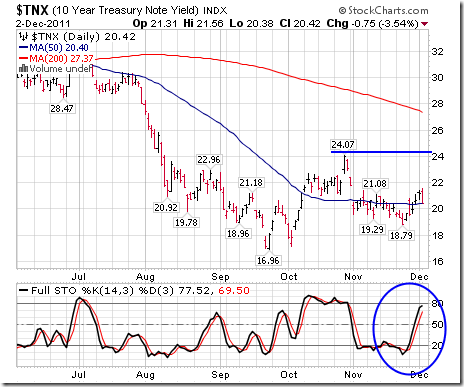
The Agriculture ETF slipped $0.14 (0.27%) last week. Intermediate trend is up. Support has formed at $50.80 and resistance is at $53.19. Units trade above their 200 day moving average, but fell below their 20 and 50 day moving averages on Friday. Short term momentum indicators are neutral. Strength relative to the S&P 500 Index remains positive. ‘Tis the season”!
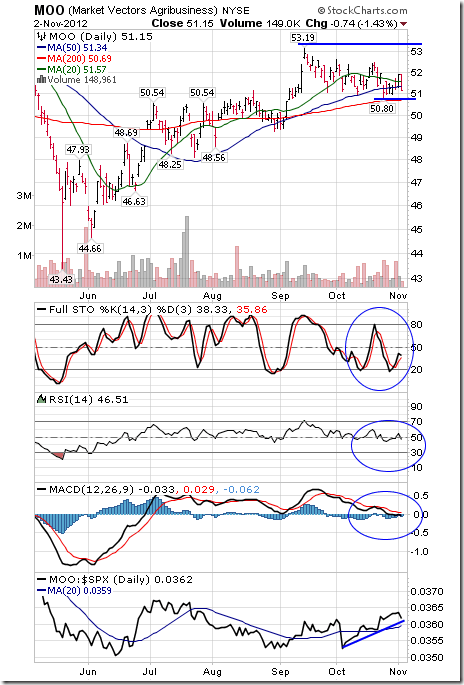
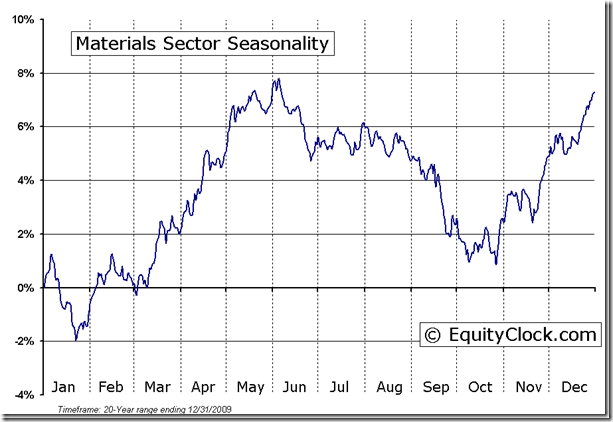
Other News
The election on Tuesday is the primary focus for equity markets this week. Equity markets are expected to remain virtually unchanged on Monday and Tuesday prior to the news. Polls show the Presidential race at a dead heat. If results come down to the winner of Ohio, a final selection of the next President may be delayed until November 16th when votes triggered by absentee ballots will have been counted. Polls also suggest that Republicans will maintain control of the House of Representatives and Democrats will maintain control of the Senate. A Congressional stalemate is expected to continue after the election. Changes in Congress likely will impact attempts to forestall the “Fiscal Cliff”. Weather conditions (possible Nor-Easter on Election Day) could influence attempts to “get out the vote”.
The VIX Index slipped 0.22 (1.24%) last week despite a gain of 0.90 on Friday. Intermediate trend is up.
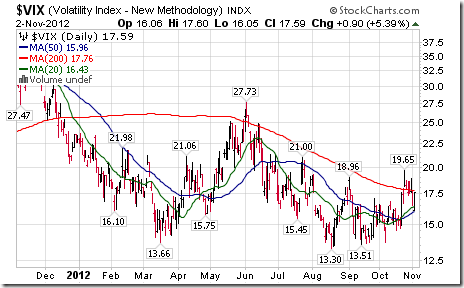
…..read more about economic news this week & vuew 47 charts HERE
Dreman is a legend because of what he did in 1979. I explained it as I introduced him at an investment conference. Here’s what I said:
David Dreman literally wrote the book on contrarian investing strategies. Consider this: His book called Contrarian Investment Strategies came out in 1979…
You have to realize, when the book came out, stocks had done nothing for a dozen years. David said that it was time to buy stocks – that they were incredibly cheap.
I bet David and his mom were the only people to buy the book… NOBODY wanted to buy stocks back then.
But he got it exactly right. The greatest two decades in the entire history of stocks was from 1979 to 1999. And Dreman, more than anyone else, called it.
I love that Dreman didn’t listen to what anyone else had to say. In 1979, he trusted his own research.
He understood that stocks were dirt-cheap and out of favor. After a dozen years of poor performance in stocks, investors were busy buying gold and bonds and avoiding the stock market. Sound familiar to today?
What’s Dreman saying today?
These days, he’s fearful of inflation, and he believes stocks are the place to have your money… He’s been writing a column for Forbes for 30 years. Here’s what he said in his most recent column:
Smoldering inflationary fires will burst into an inferno once the unemployment rate falls below 7.5%, if not sooner. In this environment, good stocks, not Treasuries, are the place to be.
What’s he doing with money now?
Given my bullish views, I am in buying mode… We will undoubtedly have more scares and volatility ahead, but if you’ve taken an ultraconservative approach to date, it’s time to revamp your assets in preparation for rising inflation and interest rates.
Dreman wrote a white paper on “The Case for Inflation” in 2011. In it, he said:
We think it’s unquestionable that inflation is in our future for some time… it’s just as certain that a portfolio of great companies will protect an investment portfolio from the challenges to come.
You can read Dreman’s white paper on inflation HERE or click on the image below (link fixed)
Dreman doesn’t follow the crowd. He is the ultimate contrarian.
And right now, this contrarian is expecting inflation, and he believes high-quality stocks (like cigarette giant Altria and banking giant Wells Fargo) are the best place to be positioned.
I suggest you follow his lead…
Good investing,
Steve
About Dr. Steve Sjuggerud
Founding Editor, DailyWealth
In a nutshell, our investment philosophy here at DailyWealth is this: Buy things of extraordinary value at a time when nobody else wants them. Then sell when people are willing to pay any price.
“It looks to me as though some kind of a large top has formed during late-September and October. But the mystery (there’s always a mystery) — what could this “top” mean? We see the breakdown to 13,039. Ah, and here’s the fascinating part of it. What could the market be telling us?”
Is the Frankenstorm symbolically hinting of our future?
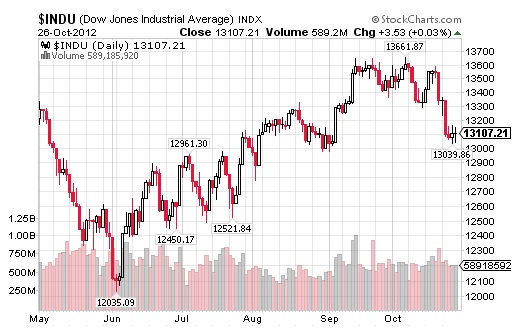
So what should we, as investors, do about it? My oft expressed answer is that we don’t have to do anything about it. The strategy that I have chosen is to sit on the sidelines with a portfolio clean of stocks. Or maybe for those who have strong stomachs and an urge for excitement, limited positions in GDX and GDXJ. The latter on the thesis that gold is acting well, despite general market weakness.
I’ve been so busy moaning about the lagging gold mining stocks that I totally forgot about the silver stocks. I’ve been saying repeatedly that silver is “dirt cheap” but I neglected to look at the silver stocks that were selling at prices that were cheaper than dirt.
But wait — why have silver stocks been rocketing higher? Some shrewd operators must believe that silver is about to make a big move skyward. And if silver is going to surge, then the silver move should rub off on gold. One ounce of gold now buys a fat 53.4 ounces of silver.
Silver is still selling on the bargain table, and the silver stocks were selling below bargain table prices. But look at the silver stocks now. Something BIG could be brewing. Maybe it’s time to buy GDX and GDXJ or even SLV. Silver, the “forgotten” commodity, is coming into its own. How do we know that? The silver stocks are telling us so.
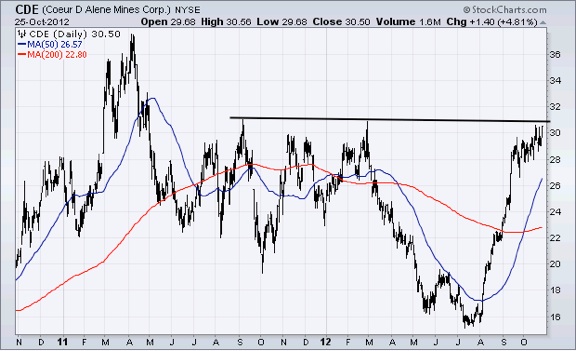
And here’s Silver Wheaton, having moved nicely from around 2 to 40. Lesson — Buy ’em when they’re dead, and when nobody wants ’em.
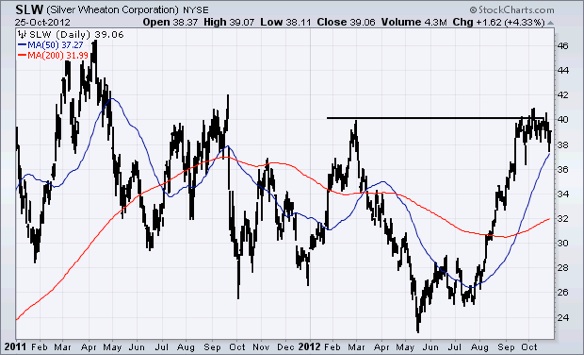
Below is Hecla — in a symmetrical triangle, which should soon break out to the north.

Below — GLD, my proxy for gold. Moving averages are on a bullish “golden cross” with the histograms for MACD in the process of turning up. Slow stochastics, just off the bottom are in the process of turning up.
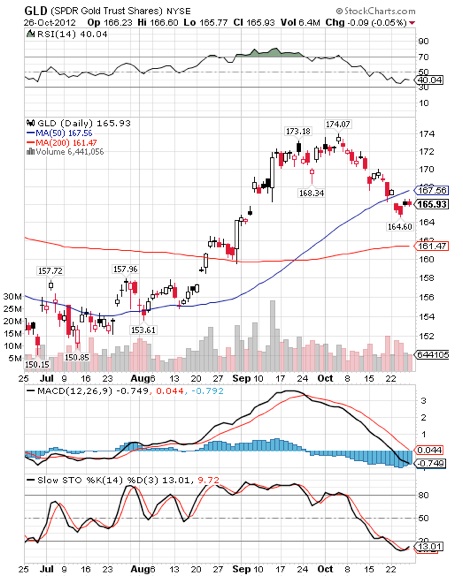
To subscribe to Richard Russell’s Dow Theory Letters CLICK HERE.














